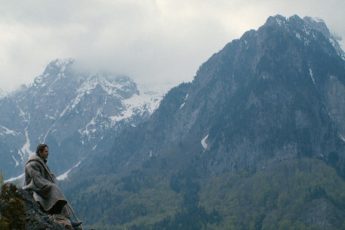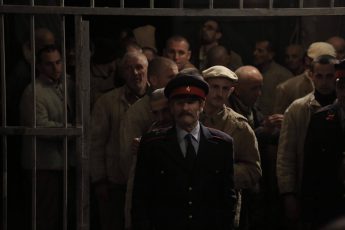Love and National Prejudice
Eduart Grishaj’s Sophia (Sofia, 2022)
Vol. 130 (December 2022) by Fabio Bego
Inspired by the memoirs of Zef Pllumi, an Albanian Catholic priest and writer who spent over twenty years in Communist prisons, Eduart Grishaj has made a film about war, memory, and forgiveness. Sophia (Rozafa Celaj) is a student of Albanian language at the University of Belgrade, Serbia who travels to Albania to seek answers about the story of her great-grandfather, who was rescued by an Albanian woman during World War II. There she meets Arbër (Antonio Kodrinaj), with whom she falls in love, and other characters that make her discover local hospitality and the odd contradictions of the country that add a twist of humor to the drama.
Arbër aids Sophia in her quest to gather information on the woman that had helped her great-grandfather. Sophia’s intrepid and fresh spirit makes Arbër rediscover the passion for music that he was forced to abandon by his father, who wanted him to work in the family business. After familiarizing themselves with the people and site of contemporary Tirana, the couple embark on a trip for the Albanian mountains, which hold the most beautiful and painful secrets of the story.
Albanian-Serb relations are a recurrent theme of recent Balkan films and are often explored in the context of Kosovo. Sophia pulls the focus away from post-Yugoslav conflicts that have monopolized intellectual efforts to tackle Albanian-Serb relations in films and in historiography. The story is staged in Belgrade, Tirana, and Northern Albania between the early 1940s and the present. The film suggests that the relationship between the neighboring peoples is not only a case for criminologists, but that it is also characterized by love and mutual respect, nuances that should be taken into account in imagining a common future. The great-grandfather’s diary that guides Sophia’s journey into her Albanian past, functions as a counter-cultural tool that puts her against the currents of hatred that often erupt in public manifestations such as football matches. The story is mostly told from the perspective of Serbian characters. This choice gives Albanian audiences a humanized image of their neighbors. However, it is also a way of avoiding the question of Albanian responsibility in bilateral conflicts.
The narrative unfolds in two parallel and crisscrossing eras. Events that take place in 1941 interact with the present and vice-versa. Although the connection between the two storylines is sometimes unclear, it triggers the curiosity of the spectator, who is left craving for the next plot development. The setting does not always cohere with the situation of Albania and Yugoslavia in World War II though, when both countries were occupied by the Axis powers. In the film, Albanian-Serb solidarity and dialogue are presented as exceptional convergences in a context otherwise dominated by mutual spite. This perspective reflects the tendency to exclude peaceful everyday relations between Albanians and Serbs from historical reflection. Moreover, the film overlooks concerted cooperation efforts in the partisan resistance against Nazi forces, an important aspect of Albanian-Serb relations in this crucial historical moment. Whether intentional or not, this punctual amnesia points to the way in which hegemonic gazes on Balkan history and politics affect the production of cinematic stories.
The film emphasizes the tragic destiny of Albanian-Serb relations and the importance of strengthening social bonds between the two communities. Sophia clearly portrays how difficult it is for individuals to overcome the prejudices that are embedded in state-building practices. Against the backdrop of the Albanian highlands, which call to mind the paintings of Edward Lear, the director often playfully exploits stigmatized visions of Albanianness in order to amuse cinema audiences. The lo-fi pads of the soundtrack bring to mind Albanian 1990s and early 2000s TV films. This reference could be stylistically driven, but is not sufficiently elaborated on to leave a sign on the spectator’s acoustic retention of the film. By putting female characters at the center of the plot, the director and the screenwriters emphasize the protective and caring role of women vis-à-vis the aggressive, vengeful, and vile nature of men. The endeavor to praise women’s function in human history, if in a stereotypical way, is counterbalanced by the sexualized representation of the young female characters. While some dialogues are intense and clearly express the pacifist message of the film, other scenes remain shallow and lend the film a kinky undertone that defies the drama that envelops the characters.
Sophia contains elements of the Balxploitation genre that emerged between the 1980s and 1990s and that has been adopted by filmmakers working with different budgets and on different continents. The film does not transcend the clichés that are generally associated with Albania and Albanian-Serb relations. However, it deals with a socially sensitive topic and does challenge the usual xenophobic narratives that dominate newspapers as well as social media and TV channels in Albania and Serbia.




Leave a Comment